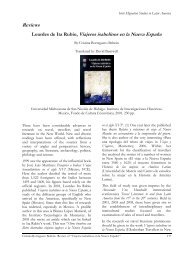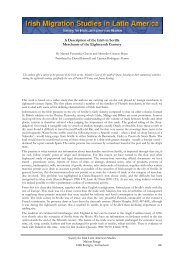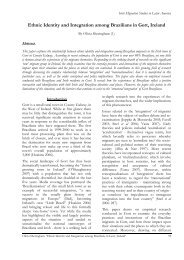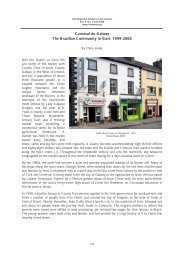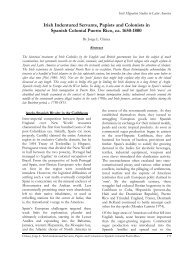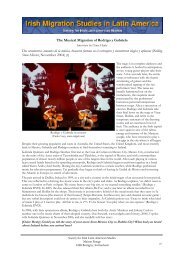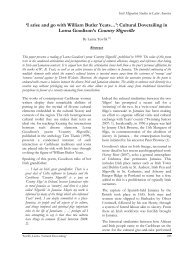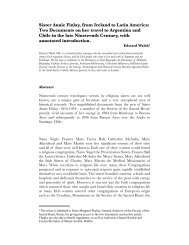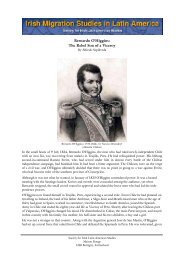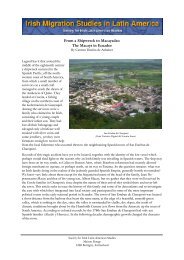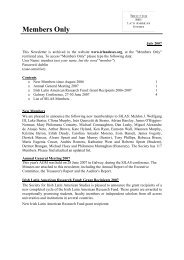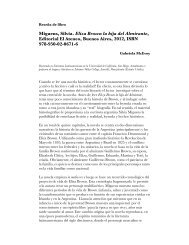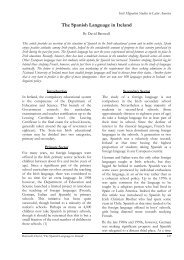I:6 Anti-dumping - Society for Irish Latin American Studies
I:6 Anti-dumping - Society for Irish Latin American Studies
I:6 Anti-dumping - Society for Irish Latin American Studies
Create successful ePaper yourself
Turn your PDF publications into a flip-book with our unique Google optimized e-Paper software.
The second period, 1851-1889, is marked by iron and steel sailing ships and, in particular, by steam. 'The<br />
major effect that steam power appears to have had was that it reduced the length of the journey from<br />
around three months to about thirty days' (McKenna 1994: 147). The shorter journey was used in private<br />
letters as an argument to convince others to visit Argentina. On 28 August 1863, Fr. Anthony Fahy, the<br />
Chaplain of the <strong>Irish</strong> in Argentina, wrote to his superior Fr. Goodman: 'I wish you would think of taking<br />
a trip out here when you are relieved from the cares of office - the steamers from Liverpool arrive here in<br />
twenty six days now! - Seven thousand miles is great travelling!' [Ussher 1951: 103].<br />
Steamships were far superior vessels, to such a degree that the last sailing ships were built by 1855. Sailing<br />
packets carried emigrants to South America <strong>for</strong> another twenty years but they steadily lost ground to<br />
steamers. The transition from sail to steam was radical. The introduction of steam packets ‘on the Brazil<br />
and River Plate trade route in 1851 brought an immediate speeding up of the pace of communications’<br />
[Howat 1984: 147]. For instance, the Royal Mail Steam Packet Co.’s Teviot left Southampton on 1<br />
January 1851 and arrived at Buenos Aires on 18 February of the same year (49 days). Thirteen years later,<br />
a letter from John Murphy was stamped on 27 May 1864 in Buenos Aires, 4 July in London, and 5 July in<br />
Wex<strong>for</strong>d (39 days).<br />
In spite of the better speed and efficiency of the steamers, even in the late 1880s conditions on board <strong>for</strong><br />
poor emigrants did not improve. 'Many of the emigrant ships had, [Fr. van Tricht, a priest defending the<br />
rights of emigrants] asserted excellent first and second class accommodation, but no cabins or partitions of<br />
any kind <strong>for</strong> the emigrants. Between decks a <strong>for</strong>est of iron poles, on which the hammocks, sometimes<br />
1,000 in number, are slung in three layers, <strong>for</strong> men, women, and children together, with no possible<br />
privacy of decency, spreading a moral contagion to which he could only allude be<strong>for</strong>e his present audience,<br />
and inducing an atmosphere which baffles description. Such was often the emigrants' accommodation, in<br />
spite of Government Regulations ordering the separation of the sexes and families. He attributed the<br />
deaths which invariably occur during the passage out to the over-crowding and utter disregard of all<br />
sanitary and hygienic rules which prevail on board many of the emigrants ships. [Fr. van Tricht] had been<br />
assured by many of his correspondents that the food, though sufficient in quantity, was execrable in<br />
quality, and often quite uneatable' [Vivian to Salisbury, 20 April 1889].<br />
From 1851 onward, the Royal Mail Steam Packet Co. was the major carrier of cargo and passengers from<br />
the British Isles to the River Plate. The service was inaugurated with the above-mentioned ship Teviot.<br />
‘The gently shelving estuarine shores of the River Plate presented difficulties in the landing of passengers<br />
and goods at Buenos Aires. Bushell […] reports how the Esk anchored about 12 kilometres off the city,<br />
with the passengers and mails being transferred to a tiny steamer to steam to within 3 kilometres of the<br />
shore. The next transfer was to an open whaler, which was sailed or rowed to about 200 yards off the<br />
shore. The long-suffering passengers were then taken by a horse-drawn, large-wheeled cart to a wooden<br />
jetty and, at last, reached terra firma’ [Howat 1984: 111]. Murphy adds that ‘in those days [1844], sailing<br />
vessels anchored far out in the river; from there they came as far as possible in rowing boats and then on in<br />
carts. When the tide was high, the boats came in as far as the Merced Church, and were tied up to iron<br />
rings in the wall of the church. For many years after, those rings were still there’ [Emily Murphy 1909: 1].<br />
During the 1860s and 70s, which marked the peak of <strong>Irish</strong> emigration to Argentina (with the exception of<br />
1889 Dresden), the most active shipping company was Lamport & Holt, or Liverpool, Brazil and River<br />
Plate Steam Navigation Co. Lamport & Holt was established in 1845. In 1863, they began to sail to and<br />
from Brazil and the River Plate. In that year, ‘the Company despatched 2 vessels to South America from<br />
Liverpool; in 1864, 8; in 1865, 24; and in 1866, 41’ [Howat 1984: 159]. Their business was carefully<br />
planned, as part of the migration market that began to increase significantly during those years.<br />
The number of British settlers in these States [Uruguay and Argentina] is immensely large – and, unlike<br />
most other fields which attract Emigration, they comprise all classes of society from Upper middle class<br />
downwards. A very great number of the estancias and saladeros (ranches and meat-salting plants) in the<br />
country are the property of and managed and worked by Englishmen [Lamport to Scudamore, 15 June<br />
1868, in: Howat 1984: 161].<br />
In 1868, Lamport & Holt signed the contract with the Royal Mail to service South <strong>American</strong> ports. The<br />
fifth article of the agreement established that ‘the voyage from Liverpool to Buenos Aires was to take no<br />
more than 34 days, including the stoppages at Rio de Janeiro and Montevideo’ [Howat 1984: 162].<br />
Indeed, that year the average journey was 30.5 days, and in 1869, 30.8 days. Later in the late 1880s,<br />
Edmundo Murray, The <strong>Irish</strong> Road to South America..................................................................... 37



